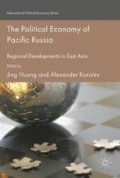Abstract
Russia’s comprehensive turn to Asia through the accelerated development of its Far East and Siberia, officially announced soon after Vladimir Putin returned to power in 2012,1 is ongoing. This has attracted the attention of a number of scholars who have delved into its causes and consequences, and who have tried to assess its feasibility (Hill and Lo 2013; Karaganov and Makarov 2014; Keck 2014; Makarov et al. 2014; Rozman 2014; Huang and Korolev 2015; Korolev 2016). The protracted crisis in Russia’s relations with the West in the wake of the Ukraine Crisis, on the one hand, and disillusionment about the West, particularly the EU development model, on the other, have given an additional powerful push and determination to Putin’s “go east” strategy. Despite the lack of an absolute consensus about the preferred model of socio-economic development of Pacific Russia’s territories and the ongoing debate over the overall attractiveness of the comprehensive reorientation to Asia,2 there is a growing recognition among intellectuals and policy-making elites in Russia that the country’s integration into the Asia-Pacific economic system through developing its Far East and Siberia is essential for restructuring its economy and improving its geopolitical standing. In other words, Russia’s integration into Asia-Pacific has become more a question of “how” rather than “if” or “why.” It is more about how Russia will create and implement its development plans for Siberia and the Far East, and how these plans can be optimised with the overall reorientation to Asia so as to avoid the resource trap and to diversify its export markets, rather than about fundamentally questioning whether Russia should carry out such policies.
The term “Pacific Russia” in this introduction denotes the territory of Russia’s Far East and Siberia. The concept of “Pacific Russia” is further elaborated in Chap. 2. It represents a vast area of Russia’s land and sea area related to Siberia and the Far Eastern Federal District.
Access this chapter
Tax calculation will be finalised at checkout
Purchases are for personal use only
References
Hill, F., & Lo, B. (2013). Putin’s pivot: Why Russia is looking east. Foreign Affairs. Retrieved April 7, 2016, from http://www.foreignaffairs.com/articles/139617/fiona-hill-and-bobo-lo/putins-pivot
Huang, J., & Korolev, A. (Eds.) (2015). International cooperation in the development of Russia’s Far East and Siberia. Basingstoke: Palgrave Macmillan.
Karaganov, S., & Makarov, I. (2014). Strategy in the 21st century: Turn to the east (Стратегия 21: поворот на Восток). Vedomosti. Retrieved April 7, 2015, from http://www.vedomosti.ru/newspaper/articles/2014/01/28/povorot-na-vostok
Keck, Z. (2014). Russia accelerates Asia pivot. The Diplomat. Retrieved April 8, 2016, from http://thediplomat.com/2014/04/russia-accelerates-asia-pivot/
Korolev, A. (2016). Russia’s reorientation to Asia: Causes and strategic implications. Pacific Affairs, 89(1), 53–73.
Larin, V. (2015). Strategic priorities of Pacific Russia’s development (Стратегические приоритеты развития Тихоокеанской России). World Economy and International Relations (Мировая экономика и международные отношения), 6, 23.
Makarov, I., Barabanov, O., Bordachev, T., Kanaev, E., Larin, V., & Ryzkov, V. (2014). Toward the great ocean—2, or Russia’s breakthrough to Asia. Moscow: Valdai Discussion Club. Retrieved April 13, 2016, from http://valdaiclub.com/publication/67120.html
Medvedev, D. (2015). The new reality: Russia and the global challenges. Rossiiskaya Gazeta. Retrieved April 7, 2016, from http://www.rg.ru/2015/09/23/statiya-site.html
Netreba, P., & Milukova, Y. (2015). Putin will be advised to reduce the government staff (Путину предложат сократить правительство). RBK (РБК). Retrieved April 7, 2016, from http://www.rbc.ru/economics/15/10/2015/561fdf359a794761d7a9ec5d
Putin V. (2012). Russia and the changing world (Россия в меняющемся мире). Rossiiskaya Gazeta. Retrieved April 7, 2016, from http://m.rg.ru/2012/02/27/putin-politika.html
Putin V.V. (2007). Russia and APEC: Towards sustainable and stable development of the Asia-Pacific region (Россия и АТЭС: к устойчивому и стабильному развитию Азиатско-Тихоокеанского региона), published in various medial of APEC member states on 7 September 2007. Retrieved April 7, 2016, from http://kremlin.ru/events/president/transcripts/24518
Rozman, G. (2014) The Russian pivot to Asia. The Asan Forum. Retrieved April 15, 2016, from http://www.theasanforum.org/the-russian-pivot-to-asia/
Author information
Authors and Affiliations
Editor information
Editors and Affiliations
Rights and permissions
Copyright information
© 2017 The Author(s)
About this chapter
Cite this chapter
Korolev, A., Huang, J. (2017). Introduction: Re-embedding Pacific Russia in the Changing Regional Environment. In: Huang, J., Korolev, A. (eds) The Political Economy of Pacific Russia . International Political Economy Series. Palgrave Macmillan, Cham. https://doi.org/10.1007/978-3-319-40120-1_1
Download citation
DOI: https://doi.org/10.1007/978-3-319-40120-1_1
Published:
Publisher Name: Palgrave Macmillan, Cham
Print ISBN: 978-3-319-40119-5
Online ISBN: 978-3-319-40120-1
eBook Packages: Political Science and International StudiesPolitical Science and International Studies (R0)

